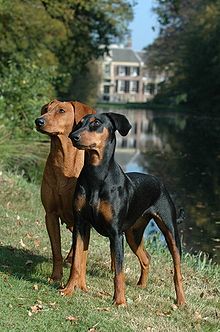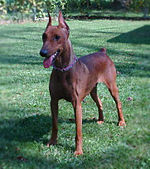- German Pinscher
-
German Pinscher
Deutscher Pinscher
A red and a tan and black pinscher Other names Deutscher Pinscher Country of origin Germany Traits Classification and standards FCI Group 2 Section 1.1:Pinscher #184 standard AKC Working standard ANKC Group 6 - Utility standard CKC Group 6 - Non-Sporting standard KC (UK) Working standard NZKC Utility standard UKC Terrier standard Dog (Canis lupus familiaris) The German Pinscher (original name Deutscher Pinscher, FCI No. 184) is a medium-sized, breed of dog, a Pinscher type that originated in Germany. The breed is included in the origins of the Dobermann, the Miniature Pinscher, the Affenpinscher, the Standard Schnauzer (and by extension the Miniature Schnauzer and Giant Schnauzer). The breed is rising in numbers in the U.S., mainly due to their full acceptance to AKC in 2003. In Australia the breed is established with a rise in popularity becoming evident.
Contents
Appearance
The German Pinscher is a moderately small sized dog , usually weighing between 25-35 pounds and typically 17-20 inches in height, with a short coat. [1] The ideal German Pinscher is elegant in appearance with a strong square build and moderate body structure, muscular and powerful for endurance and agility.
Colors for this breed include black and rust, red, fawn, and blue and tan. For all countries where the Fédération Cynologique Internationale standard applies, only black and rust and solid red are allowed colors.
There are also a few colors for this breed that became extinct during the world wars of the twentieth century. These include solid black and salt-and-pepper as well as harlequin.
The coat should be short and dense, smooth and close lying. German Pinschers customarily have their tails docked and ears cropped, as has been done for over 200 years, in countries where the procedures are legal[2]. Historically[3], tail docking was thought to prevent rabies, strengthen the back, increase the animal's speed and prevent injuries when working. Also for utilitarian reasons, ears were cropped[4] to prevent injuries while working and increase the intense appearance of the canine and eliminate the subdued, "puppy" look of droopy ears. Today, these are both done mainly for cosmetic reasons, though many accounts of injuries to undocked tails and uncropped ears of unaltered dogs have been reported and recognized by the American Kennel Club[5]. Cropping and docking should only be done by a licensed veterinarian. While the altered or natural state of a German Pinscher should not effect a judge's decision in the show ring, prejudices do exist. Even many foreign judges who officiate at AKC events comment on how they appreciate seeing dogs docked and cropped.
History
The Wire Haired and Smooth Haired Pinschers, as the Standard Schnauzer and German Pinscher were originally called, were shown in dog books as early as 1884. However drawings of the German Pinscher date back to at least 1780,[6] and the breed likely traces its roots to varieties of ratters well established on farms in Germany as far back as the 15th century.[7] These medium-sized dogs descended from early European herding and guardian breeds.
 Drawing of a German Pinscher and a Miniature Pinscher (Pinscher und Zwergpinscher), 1888.
Drawing of a German Pinscher and a Miniature Pinscher (Pinscher und Zwergpinscher), 1888.
The source of the German Pinscher can be followed back until 1836 when this breed surpassed the Mops in popularity. Pinschers were used as guardians for coaches. They also lived in homesteads where they were used to kill vermin, a job they completed independently by instinct. This behavior did not need to be trained into the German Pinscher. Even today you can observe German Pinschers searching for and finding rats in open areas and in homes. This high prey drive is a good reason not to leave a German Pinscher off lead outside of a fenced area.
The Standard Schnauzer (then referred to as the Wire Haired Pinscher) was originally born in the same litter as the German Pincher. Over time, breeders decided to separate the "varieties," changing them to actual "breeds". After three generations of the same coat were born, the Pinscher-Schnauzer club allowed them to be registered as their respective "breed".
From 1950 to 1958 no litter had been registered. Credit is attributed to Werner Jung for collecting several of the breed in 1958 to continue the German Pinscher as we know the breed today. Westminster Kennel Club's first German Pinscher Best of Breed winner, 2003[8]
Westminster Kennel Club's first German Pinscher Best of Breed winner, 2003[8]
 Westminster Kennel Club's first German Pinscher Best of Opposite Sex winner, 2003[9]
Westminster Kennel Club's first German Pinscher Best of Opposite Sex winner, 2003[9]
The German Pinscher came to breeders in the United States in the early 1980s, though accounts of singular German Pinschers appearing in the country before then have been noted. In 1985, the German Pinscher Club of America was started by various German Pinscher fanciers, most of whom are no longer active in the breed. At this time, the German Pinscher was shown in rare breed shows. They were also recognized by the United Kennel Club.
The German Pinscher gained full acceptance by the Canadian Kennel Club[1] in 2000. The CKC named Ch Othello des Charmettes its first Champion on April 20, 2000. The German Pinscher gained full acceptance by the American Kennel Club [2] in 2003. The AKC named Ch Riward's Rollin Rocs Rusty (Jambo de la Capelliere[3] x Windamir's Zarra) its first Champion on January 8, 2003.In 2004, the German Pinscher competed at its first Westminster Kennel Club[4] show. The Best of Breed winner was Ch. Windamir Hunter des Charmettes(Windamir's Sayzar x Lot T Da Des Charmettes). The Best of Opposite Sex to Best of Breed was Ch. Windamir's Chosen One (Tanner's Morning Star x Windmir's A-blazin at RG's).
Extinct varieties
There are several now-extinct varieties of the German Pinscher:[10]
- Harlekinpinscher (Harlequin Pinscher, for the merle coloration)
- Schweizer Pinscher (also called the Jonataler Pinscher, Pfisterlinge, Silberpinsch, Swiss Salt and Pepper Pinscher, Swiss Shorthair Pinscher)
- Seidenpinscher (also called the German Silky Pinscher, Silky Pinscher)
Some of these may have recently been re-formed from the German Pinscher and marketed as rare breeds for those seeking unique pets.
Health and temperament
Temperament
A well bred German Pinscher will be a loving companion with an even temperament. Temperament is hereditary. When considering adding a German Pinscher to a family, it is advised to be able to meet and touch the mother of the puppy you are offered. German Pinschers are generally friendly dogs. They are highly intelligent, quick learners who do not enjoy repetition in training. A well bred German Pinscher can be trusted with small animals and children, though no dog should ever be left unsupervised with either. If the puppy shies away when faced with strangers, it may be a sign of poor breeding.
It should also be noted that German Pinschers are very high energy dogs, in many cases requiring several hours of exercise a day. Accordingly, a large, securely fenced yard is highly recommended for anyone considering the breed as a pet.
Health
Due to the small gene pool of the German Pinscher, breeders should health test their dogs for hereditary cataracts, hip dysplasia and elbow dysplasia, von Willebrand disease, thyroid disorder, and with the increased incidences of cardiac disease[11] due to irresponsible breeding practices, German Pinschers suspect for heart issues should be removed from all breeding programs.
References
- ^ "German Pinscher: Dog Breed Selector: Animal Planet". Animal Planet. http://animal.discovery.com/breed-selector/dog-breeds/working/german-pinscher.html. Retrieved 3 November 2011.
- ^ http://www.cdb.org/
- ^ http://www.avma.org/issues/animal_welfare/canine_tail_docking_faq.asp
- ^ http://bakaridobes.westhost.com/publiceducation/PECEars.html
- ^ http://www.akc.org/pdfs/canine_legislation/position_statements/Ear_Cropping_Tail_Docking_and_Dewclaw_Removal.pdf
- ^ The German Pinscher Club of America, "Breed History". Retrieved 07/03/2009
- ^ Sharon Morgan & Dee Gannon, "The German Pinscher (Comprehensive Owners Guide)" Kennel Club Books - Special edition, ISBN 978-1-59378-355-6 (November 29, 2006), p. 9.
- ^ http://www.westminsterkennelclub.org/2004/results/breed/germanpin.html
- ^ http://www.westminsterkennelclub.org/2004/results/breed/germanpin.html
- ^ Deutscher Pinscher, by Cory Leed "from information provided by Philippe Touret", 2004
- ^ http://offa.org/cardiacstatbreed.html
External links
Categories:- Dog breeds
- Dog breeds originating in Germany
Wikimedia Foundation. 2010.

